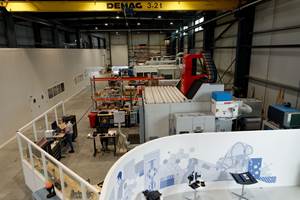Overview of CAMX 2017
CAMX 2017 was postponed, the event’s quality was not.
As I key in these words on my computer, CAMX 2017 has been history for less than five hours. I am in seat 28C on a plane flying home from Orlando, hoping that the person in front of me does not recline his seat and, thus, make an already difficult typing job an impossible one. It might be too soon for me to put the show and conference into perspective, but I will give it a shot.
First, if you are wondering if it is possible to have a major composites trade show canceled (at the last moment) in September due to a hurricane blowing through Florida, and then turn around and host that same trade show a mere three months later, and have it be a success, I can assure you it is. Possible. But not without a lot of hard work. Show organizers at ACMA and SAMPE took the September edition of CAMX 2017 almost to the finish line only to have it washed away by Hurricane Irma. Then these folks had the unenviable task of doing it all over again in December. And they pulled it off remarkably well.
The consensus at the show? Although there was some exhibitor and attendee attrition between September and December, the people who did show up were serious about the show and composites. In other words, quality seems to have won over quantity. So, hats off to ACMA, SAMPE and CAMX officials for not only making it work, but making it work well.
One question I get often at any trade show is, “So, what Earth-shattering technologies have you discovered?” The answer, inevitably, is, “Not much.” This is not to say that the composites industry is not innovating or evolving, but it is rare that a trade show is the site of those “a-ha” revelations.
That said, CAMX offered much to see and contemplate, including two robust and competitive parts contests (The CAMX Awards and the Awards for Composites Excellence), some new additive manufacturing solutions (from Vartega and Cincinnati Machine), a creative metal/composite solution for truck structures (Structural Composites), automated workcells built around filament winding (Mikrosam and Autonational), a variety of resin systems for high-speed/high-volume manufacturing (Huntsman and TenCate), some interesting nanomaterials (General Nano and N12) and a host of recycling technologies and recycled materials (Carbon Conversions, Vartega, ELG Carbon Fibre, Adherent Technologies and Addesso).
Perhaps most revelatory was not what was exhibited or introduced, but what was said. I fielded several questions from materials and equipment suppliers, as well as fabricators, about how automotive composites might evolve, and how poised they are or are not to “take off.” Of course, I don’t really know, but I was certainly willing to hazard an educated guess, which might be the topic of another editorial. Regardless, that such questions are still floating around says to me that there remains much uncertainty about how seriously automotive OEMs are taking composites.
Also “heard” was a lot of talk about next-generation aircraft programs (i.e., Airbus A320 and Boeing 737 replacements), and the composite materials and processes likely to find a place therein. The upshot here should not be surprising: Aircraft OEMs are looking for faster production rates (60+ shipsets/month), more automation (less touch labor), better process/quality control and reliable non-autoclave cure solutions. Thermoplastics, in particular, seem uniquely well positioned to meet many of these requirements. The material/process window for such programs seems to be 2020-2025.
I am happy to report that the gentleman in 27C did not recline, and we will have a more detailed CAMX 2017 report in the February issue of CW, as well as at CompositesWorld.com.
Related Content
Recycling end-of-life composite parts: New methods, markets
From infrastructure solutions to consumer products, Polish recycler Anmet and Netherlands-based researchers are developing new methods for repurposing wind turbine blades and other composite parts.
Read MoreWatch: A practical view of sustainability in composites product development
Markus Beer of Forward Engineering addresses definitions of sustainability, how to approach sustainability goals, the role of life cycle analysis (LCA) and social, environmental and governmental driving forces. Watch his “CW Tech Days: Sustainability” presentation.
Read MoreCirculinQ: Glass fiber, recycled plastic turn paving into climate solutions
Durable, modular paving system from recycled composite filters, collects, infiltrates stormwater to reduce flooding and recharge local aquifers.
Read MorePlant tour: Daher Shap’in TechCenter and composites production plant, Saint-Aignan-de-Grandlieu, France
Co-located R&D and production advance OOA thermosets, thermoplastics, welding, recycling and digital technologies for faster processing and certification of lighter, more sustainable composites.
Read MoreRead Next
“Structured air” TPS safeguards composite structures
Powered by an 85% air/15% pure polyimide aerogel, Blueshift’s novel material system protects structures during transient thermal events from -200°C to beyond 2400°C for rockets, battery boxes and more.
Read MorePlant tour: Daher Shap’in TechCenter and composites production plant, Saint-Aignan-de-Grandlieu, France
Co-located R&D and production advance OOA thermosets, thermoplastics, welding, recycling and digital technologies for faster processing and certification of lighter, more sustainable composites.
Read MoreAll-recycled, needle-punched nonwoven CFRP slashes carbon footprint of Formula 2 seat
Dallara and Tenowo collaborate to produce a race-ready Formula 2 seat using recycled carbon fiber, reducing CO2 emissions by 97.5% compared to virgin materials.
Read More














.jpg;maxWidth=300;quality=90)







